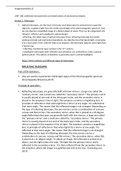Assignmentseller123
UNIT 16B: undertake measurements and observations of astronomical objects
Section 1: Telescopes
Optical telescopes, are the most commonly used telescopes by astronomers to gaze the
night sky. It gathers light from the visible wavelength of the electromagnetic spectrum, here
we can observe a magnified image of a distant object in space. They can be categorized into
refractor, reflector and catadioptric optical designs
-refracting, the oldest type of optical telescopes.Every refracting telescope has similar
working principle and mechanical ingredients. An objective lens that bends light, converging
it at a focal point. Then, with the help of an eyepiece, the telescope captures more light than
a human eye.
- reflecting, invented by Isaac newton in the 17 th century.
- catadioptric telescopes both reflection and refraction are combined to create a special
optical system. This optical combination is generally used in vehicle headlights.
https://www.rankred.com/different-types-of-telescopes/
REFLECTING TELESCOPES
Part of EM spectrum:
they are used to examine the visible light region of the electromagnetic spectrum.
(Encyclopaedia Britannica,2019)
Principle of operation:
Reflecting telescopes are generally built with two mirrors, a large one called the
"primary mirror" and a small one called the "secondary mirror." The primary mirror
is usually placed at one end of the telescope's tube, and the secondary mirror is
placed in the eyepiece's line of sight. The eyepiece contains a magnifying lens. A
principle of reflection is that when light hits a mirror at any angle, it is reflected at
that same angle. This means that the reflected image is not changed. Depending on
the type of reflecting telescope, the two mirrors can be a combination of concave,
convex and flat mirrors. The secondary mirror, when flat, is placed at a 45-degree
angle Reflecting telescopes are generally built with two mirrors, a large one called
the "primary mirror" and a small one called the "secondary mirror." The primary
mirror is usually placed at one end of the telescope's tube, and the secondary
mirror is placed in the eyepiece's line of sight. The eyepiece contains a magnifying
lens. A principle of reflection is that when light hits a mirror at any angle, it is
reflected at that same angle. This means that the reflected image is not changed.
Depending on the type of reflecting telescope, the two mirrors can be a
combination of concave, convex and flat mirrors. The secondary mirror, when flat,
is placed at a 45-degree angle. To obtain an image, the telescope is aimed at an
object, and the light enters the tube. The light hits the primary mirror and is
reflected to the secondary mirror. It is then reflected from the secondary mirror to
the eyepiece, where the image is magnified and sent to the eye. (sciencing.com,
2019)




